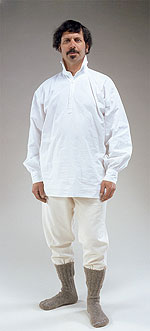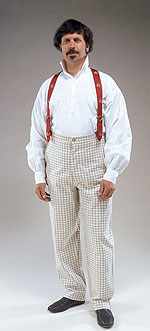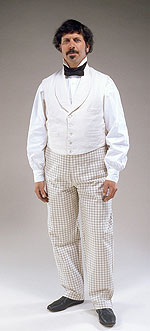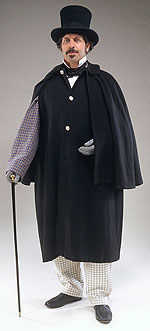




Advanced Search
Dress Up | 1st Person | African American Map | Now Read This | Magic Lens | In the Round | Tool Videos | Architecture | e-Postcards | Chronologies Turns Activities
Men's Clothing at 1860By 1860, the availability of sewing machines meant that men's clothing could be produced faster and more cheaply. Fashions in men's clothing favored looser fitting coats and trousers. Coat sleeves were very wide at the elbows, narrowing at the shoulder and cuff, a design sometimes referred to as a "balloon sleeve". Aniline dyes (made from coal tar) were new and produced brighter colors than natural dyes (made from plants) and did not fade as quickly. Clothes in bright colors and a variety of woven patterns were popular; but so were more staid garments made from extremely fine wool in black and other somber colors. Go to interactive Flash version Undergarments
DrawersDrawers serve the function of underpants. These drawers have a button fly. A man would tuck his drawers into his socks to help keep his socks up. ShirtShirts were now a little shorter than in the past as they no longer served as underwear and nightshirts (as they did in the 18th century). This shirt buttons part way down with 3 buttons. SocksMen now wore socks rather than long stockings. This man's socks are made of wool. Foundation Garments
TrousersPants made by a tailor were called trousers whereas those made in a factory were called pants. These trousers are made of linen and have a button fly - the modern zipper was not invented until the twentieth century. Creases would not become popular in pants until later in the 19th century. BracesSuspenders were called "braces" and were used for holding up trousers. Belts existed as part of special outfits (for firemen and other services), but were not otherwise common. ShoesMen's shoes came in a variety of styles and could be made of cloth or leather. This man wears "Congress Boots" with elastic sides. Elastic was a fairly new invention and like the zipper of the early twentieth century, was originally used as a shoe fastening before being introduced into other clothing.
VestVests were a common part of everyday wear. They might match just the trousers or just the coat or all three pieces might match. A man might wear his vest with any number of his vest buttons fastened or left open. StockThis man wears a stock around his neck. It is made stiff with a lining of woven horsehair. It opens in back and fastens with hooks and eyes, but a buckle and strap was another common fastening. The bow on the front is permanently tied. The stock gradually replaced the older style of neckwear called a "cravat" in which a long strip of cloth was wrapped twice around the neck and the ends were then tied in a bow. Daily Garments
Frock CoatMen did not appear in public in their shirtsleeves, even if wearing a vest. This kind of coat is called a frock coat. A frock coat was fitted to the body above the waist and had a loose skirt of fabric below. Frock coats could be made of extremely fine wool, most often black, for fall or winter, or of cotton or linen for summer. The frock coat worn by this man is made of cotton and is suitable for summer wear. The flamboyant pattern is not uncommon for lightweight coats in this period. HatThis man wears a straw top hat for summertime. Top hats were considered common everyday wear. GlovesThis man wears white cotton gloves. Kid (goat skin) gloves were more common. Outer Garments
CoatWhile a frock coat or sack coat was proper outerwear, an overcoat or cloak could be worn in cold weather. The particular style of cloak shown is called an "Inverness cloak". Its special feature is that, while it does not have sleeves like an overcoat, the short outer cape provides protection to the arms of the wearer. HatThis top hat is made of wool felt but might also have been made of a felt made from beaver fur. GlovesStylish gentlemen wore gloves when they went out in public. The gloves shown here are made of silk. Kid (goat skin) and cotton were also common materials for making gloves. CaneStylish men liked to carry canes when they went out in public, whether they needed them for walking or not. Canes were usually small and lightweight. This one has a gold top. See Also...
|
| |
Home | Online
Collection | Things
To Do | Turns Exhibit | Classroom | Chronologies My
Collection
About This Site | Site
Index | Site Search | Feedback




